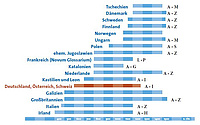Thematic and Geographic Focus
The Mittellateinische Wörterbuch addresses Latin texts originating in the German speaking area during the Middle Ages. It also evaluates important documents of that era related to German history, in particular sources of the Frankish Empire and the so-called Kingdom of Italy. Beyond the dictionary’s actual geographic boundaries also texts of specialist literature were included in order to ensure that specific terminology regarding the fields of theology, church history, history of liturgy, philosophy, ethics, logic, mathematics, geometry, computus, astrology or astronomy, zoology, botany, alchemy, pharmacy, medicine, anatomy, surgery, jurisprudence, canon law, grammar and music would be given due consideration.
Therefor the Italian MLW corpus e.g. includes the papal Liber Diurnus, medical texts from Salerno and a Southern Italian work on hippiatrics, documents and historiographical texts from Northern Italy, the British area or from Poland.
This reach beyond the German speaking area is owed to the circumstances at the time the dictionary was initiated, when it was not yet forseeable, in how many different ways the individual countries eventually would contribute to a new «Du Cange».
(also see Medieval Latin Dictionary Projects).
The Processing Period
For the user, the most important difference to the Novum Glossarium Mediae Latinitatis (NGML), is in the significantly extended boundaries of time, ranging from the 6th century until 1280, the year Albertus Magnus died (see also Chart of the Medieval Latin dictionary projects). For one, this way the linguistically profitable texts of the Merovingian Period are evaluated and thus a temporal connection is made to the Thesaurus linguae Latinae, the major lexicographic project on the Latin language in the times of Antiquity and the church fathers. Also the reception of Aristotle and the scholastic terminology of the High Middle Ages are integrated without impeding the project’s progress by an elaborate later differentiation in accordance with schools.

